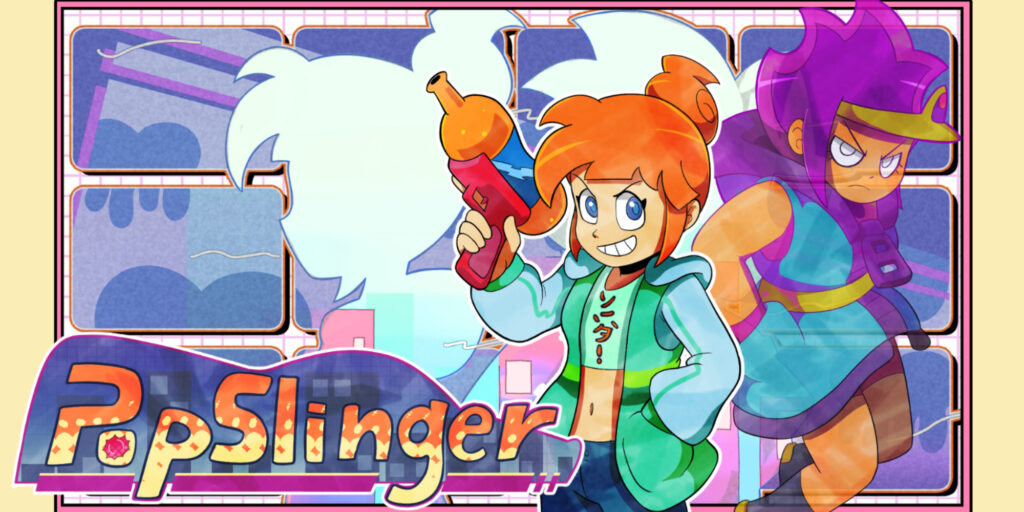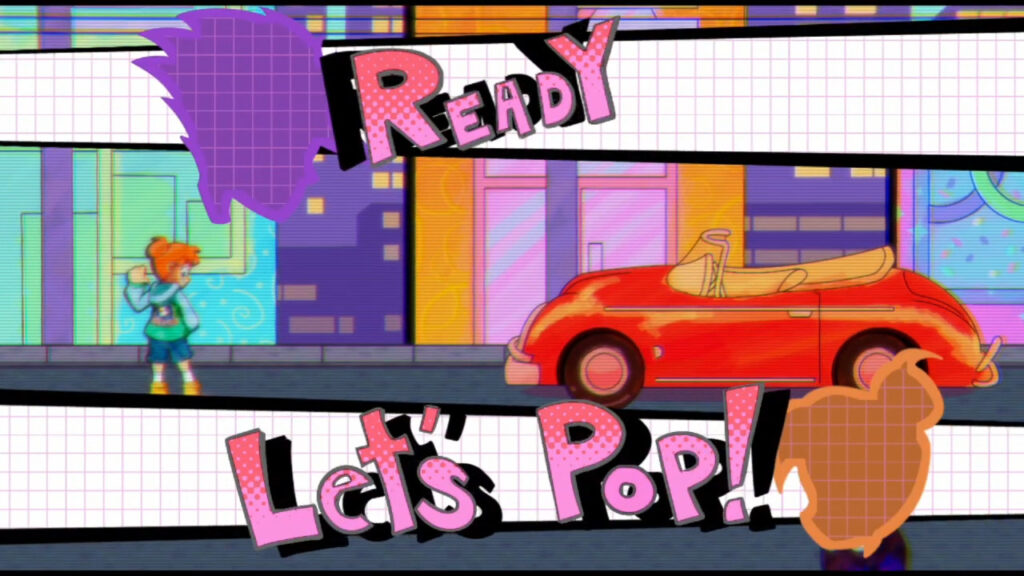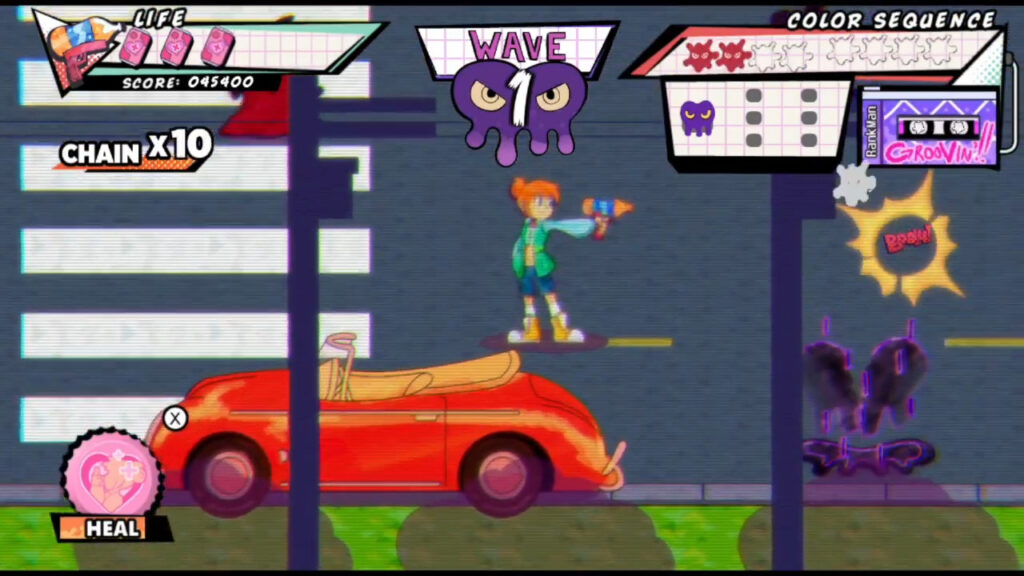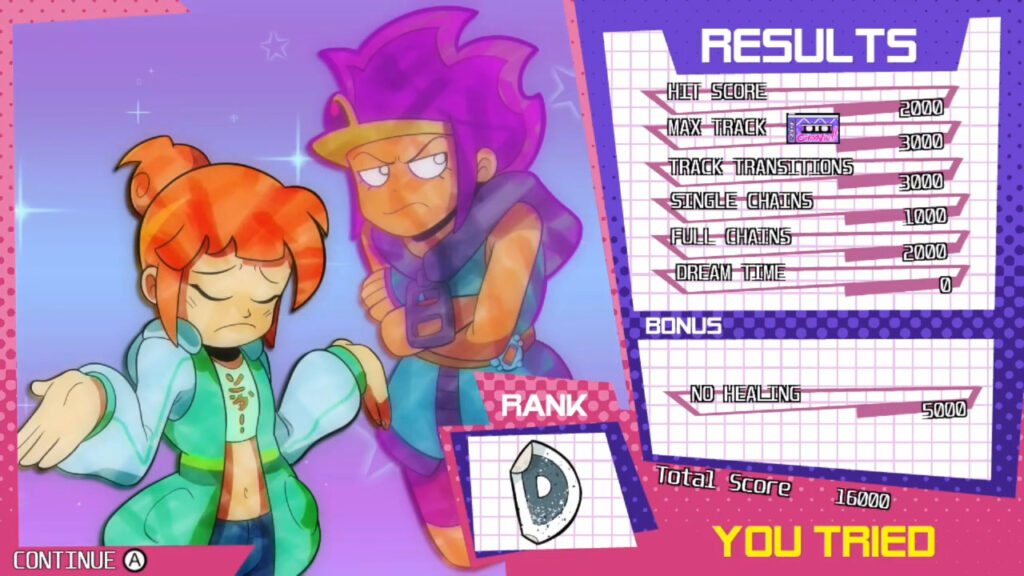
Developer: Funky Can Creative
Publisher: Funky Can Creative
Platform: Switch
Tested on: Switch
PopSlinger – Review
If you’re like us, and grew up in the 90s, then it’s always a bit confrontational when a game inspired by that decade is described as ‘retro’. PopSlinger, by Funky Can Creative is such a game, and while it does make us feel old, it also looks like a very fun arcade title. Of course, aesthetics alone aren’t enough. Is there something worth checking out beneath PopSlinger’s retro exterior?
Story
According to Funky Can Interactive, PopSlinger’s story was inspired by 90s anime. We can’t quite pinpoint which specific anime they mean, but there are indeed plenty of tropes present. The opening cutscene introduces us to our protagonist Ria and her companion Gin. Ria is a rookie PopSlinger, who is tasked with saving the world using her trusty sodapop gun. Gin is a former PopSlinger, who has now returned as a cynical ghost. This unlikely duo takes on the “Corazones”, people whose hearts have been corrupted by the dark forces from the other dimension.
Graphics
A lot of effort was put into making PopSlinger look like it came from the 90s, with its neon aesthetics -something we also saw in Fire Tonight– and the game mostly succeeds in doing so. The character and monster designs look fantastic, and although the animation is a bit too smooth for a genuine 90s product, the game does capture the right atmosphere. Admittedly, PopSlinger goes a bit overboard with the screen distortions and scanlines, and we would’ve liked to see the option to turn specific filters off, but for the most part, Funky Can Creative succeeds in what it sets out to do with the visuals. As a quick side note, while we understand the idea of implementing VHS-style effects to further drive the point home, it’s odd to see these kinds of distortions in a video game as that simply doesn’t make sense.
Sound
Accompanying the visuals is a selection of tunes inspired by the same decade. We can’t praise the curator of this playlist enough -while not every tune is our personal cup of tea, it is a perfect time capsule to capture the right atmosphere. What’s even more impressive here is that the tunes themselves aren’t actually from the 90s. This makes for a bit of a strange situation as the music feels familiar, yet unknown. Add to this that PopSlinger is fully voice acted and you’ve got an impressive soundscape.
Gameplay
You’d be forgiven for assuming PopSlinger is just another run-and-gun arcade title, based on the screenshots. The game actually requires a bit more tactical thinking than you’d expect. You’re still running and shooting enemies of course, but the gimmick here is that you become faster and more powerful -called a ‘progression’ in-game’- by shooting two sets of four enemies of the same color in sequence. This speeds up the tempo of the game and also enables you to summon Gin at the push of a button to provide you with a short bonus, such as a shield or supporting fire.
Apart from progression, which comes in three phases, there’s another state called ‘Dream Time’, which is achieved by popping specific sequences of enemies in order, like four red enemies first, followed by purple enemies. In all honesty, we only know about this feature because the instruction screen tells us about it, but we didn’t quite experience what it does in practice, as it seemed like we were never able to pop the right sequence of enemies to pull it off. We’re not sure whether or not we were missing something, or if it was supposed to be as rare as it seemingly is though. It highlights PopSlinger’s biggest gameplay issue: the necessity to seek out specific enemies in order to trigger progression. It’s easy to get caught up in the swarms of enemies and accidentally take out critters with the “wrong” color. Likewise, if you dedicate yourself to tracking down the right ones, you’ll find that you’ll have to dodge a significant number of others, which slows down the overall pace of the game.
It’s a bit of a shame that the gameplay ended up so disappointing. There’s nothing inherently wrong with the game itself: the controls were easy to pick up, the performance was smooth, and the game itself isn’t overly complicated or it will not bog you down with its mechanics. Where PopSlinger fails to be engaging though, is in its over-reliance on those simplistic mechanics. Ria feels ridiculously slow and weak, as long as she doesn’t reach any of the progression states, yet reaching that state feels tedious -and you lose any progress whenever you get hit by an enemy. We really wanted to like PopSlinger because we absolutely adore the game’s aesthetics, but any credit the game builds up in that aspect is lost by the mediocre gameplay experience. We’re not berating the game for its difficulty level -it is difficult- but the game doesn’t give you that “one more try” feeling we’ve come to know and love from other shmups either.
Conclusion
As much as we wanted to love PopSlinger -and we do, at least when it comes to the sound and visuals- the game just didn’t click with us when it came to its gameplay. Your mileage may vary if you’re a diehard run-and-gun enthusiast, but for the majority of potential players, the sheer tediousness of the core mechanics ruins what could’ve been a fantastic little game.
PopSlinger - Review,1 Comment
Leave a Reply
You must be logged in to post a comment.









[…] to fly back to the past and have some arcade-like fun with the musical beat-‘m-up shooter Popslinger. Use your soda gun, jump around dodging and blasting, and relish in the retro Japanese cartoon […]